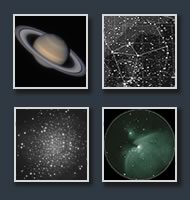Skywatcher BKP250 and NEQ6- Review
This is a "first-light" review of a Skywatcher BKP250 f/4.8 OTAW Newtonian telescope with a NEQ6 pro equatorial mount, which I'd aquired for DSO observing and planetary imaging. Despite the relatively low price - BKP250 is a moderately good all around telescope. However a some improvements are necessary in order to fully utilize capabilities of its 10" aperture.
What I did like:
- Cheap, and yet acceptable quality (optical and mechanical).
- Mobility and relative ease of setup, despite its monstorous looks. Takes me 15 minutes to put everything together, and the OTA fits easily into my car's backseat.
- Ergonomics (Skywatcher has an edge here, compared to its main competitor GSO).
- Focuser quality, considering the price. It is quite smooth, rigid and has no image shift.
- Mirror cell and spider assembly design. The primary mirrors is fairly easy to collimate and it holds collimation well.
- Pyrex primary mirror.
What I did not like:
- Vignetting - 58mm secondary is too small and cuts aperture even in the middle of FOV.
- Mount noise is quite annoying, especially at high speed slewing.
- Back focus is too long - 135mm (though it might be a plus for photographers).
- During cold temperatures the focuser tends to slip and requires adjustment.
- Not enough counterweights (enough only for a "naked" OTA)
- Mount head is bulky and heavy (cast aluminium).
- Some backlashes in the mount (RA axis).
- The supplied dovetail plate is too long and thin for such a heavy OTA.
- The OTA tends to hit tripod's legs. It can be fixed by adding a column extension for the EQ6, or using a column instead of tripod.
- There optical quality of the main mirror isn't perfect (see attached star tests) however quite acceptable for the given price, and holds magnifications of 1D well. A premium 10" mirror would cost 2-3 times more than this whole OTA.
- The secondary mirror had slight astigmatism
- Stability and dumping time (see dovetail and backlash issues).
Improvements and tweaks:
- Dovetail: I've replaced the flimsy "vixen" dovetail with a Losmandy 15" plate from ADM - and it improved overall stability and dramatically reduced the dumping time.
- Releasing the tightened primary mirror holders is a must to prevent pinched optics.
- I've replaced the secondary mirror with a larger one (described in this article).
- Mount tuning: The least is to replace its grease, center the worm gears (if required), and adjust backlashes (which also affects mount stability).
- Cooling: As in any large Newtonian a cooling fan is a must for the main mirror. I've added a large 120mm fan on the back of the OTA
- Dew control. Secondary mirror can dew up quite easily under humid conditions, which requires attaching a dew sheild of using a heater.
- Quality extension tube with a compression ring (the stock ones are rubbish).
- EQMOD cable, which enables ASCOM control over the mount by PC (i.e. Stellarium software). It's a must-have accessory for astrophotographers.
- A velcro tape to hold the SynScan controller on the mount is a big help.
- A padded wheeled bag or box for the heavy equatorial head.
- Reflex finder (such as "Telrad") as an addition to the supplied 8x50 scope.
- Flocking the OTA and the focuser tube to minimize internal reflections.
Photos:
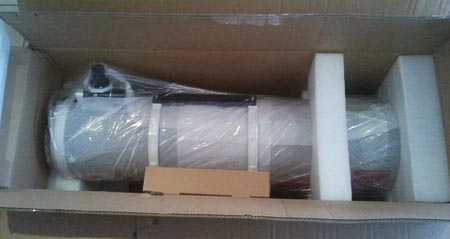
Unpacking the 10" OTA
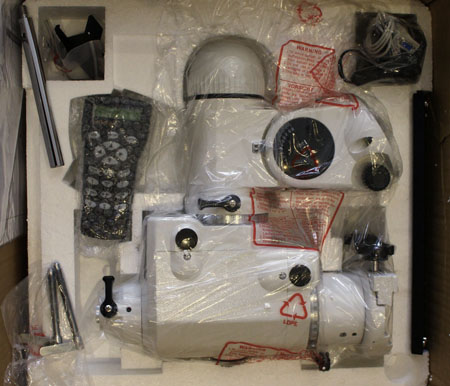
Unpacking the NEQ6 Pro mount head
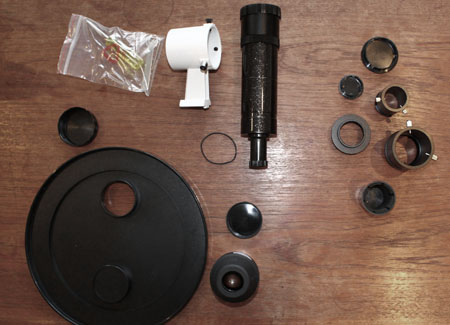
Supplied accessories and adaptors
The OTA has a nice black finish with sparkling "stars". A good surprize for me was its length: only 1.12 meters, which is fairly short for a 10" f/4.8 instrument. This is because the OTAW version is advertised as "astrophotography" instrument with a longer back-focus and shorter tube. OTA diameter is 29 cm, and it weights approximately 14kg. The tube is made from a thin rolled steel. It's relatively light and perfectly rigid for visual or planetary photography. However its deformations are noticeable under heavier loads (over 1 kg at focuser).

The OTA in its sparkling black finish
The NEQ6 mount has a heavy and bulky head (~16kg), two counterweights (which is enough if supplied shaft extender is used), and a relatively heavy and rigid steel tripod. Both losmandy and vixen style dovetails can be mounted. There is a small bubble level, which is pretty useless since it's not accurate. Synscan hand controller and a few cables complete the set.
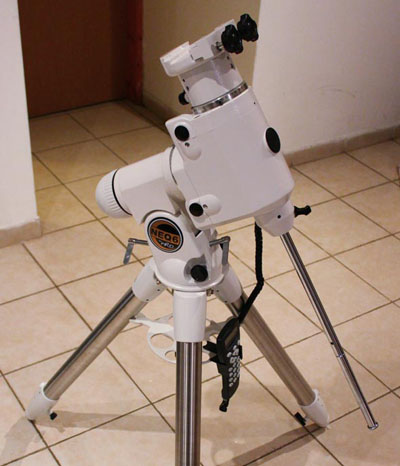
NEQ6 mount assembled
As you can imagine - the assembled scope is quite big. It's a good idea to buy or build a high observing chair for comfortable observing.

The whole setup assembled

Powering the EQ6 mount from a portable 12V Li-Ion 10Ah battery
In order to deal with stability issues - I've replaced flimsy vixen-style dovetail with a 15" losmandy-style wide plate from "ADM accessories". It definitely helped with vibrations, and improved rigidity of the whole setup. Note the bolts at two sides of the plate, which are pushing into the rings.
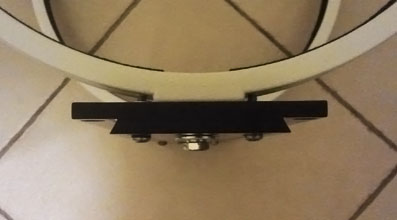
A replacement "Losmandy" dovetail plate to reduce the vibrations
The Skywatcher dual speed focuser turned out to be quite good for my purposes. Obviously it's not a "Feathertouch", but still quite pleasing to use, rigid, and has no image shift. Main drawback is its small travel.
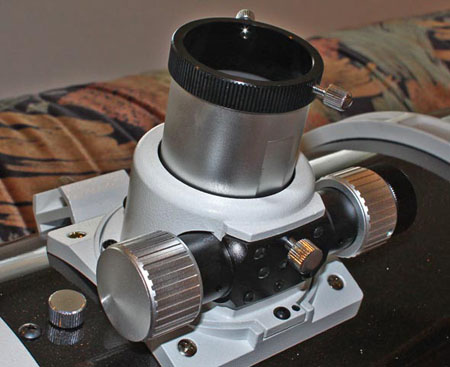
The stock dual speed crayford focuser is smooth and shift-free
Spider: it's quite thin and holds collimation of the secondary well.

The "spider" and the secondary mirror holder

10" Pyrex primary mirror held on 3 back points and 6 side points

Primary mirror collimation adjustment and set screws
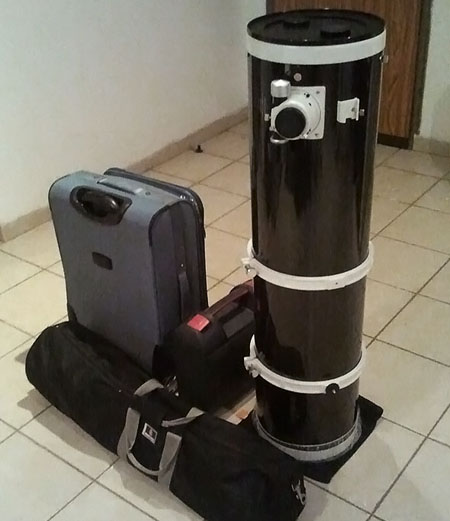
Scope packed and ready for transportation
Optics
Optical quality of this telescope is moderate, as expected from Synta's mass production parabolic mirror. It's great for deep sky observing and probably deep sky photography. However for serious planetary observing (over 250x) and imaging I would consider replacing or refiguring the primary mirror (note that a premium 10" mirror will cost more than a whole telescope).
I was able to observe hints of Saturn's Encke division and saw quite a lot of detail in its belts, as you can see in atached planetary photos. However the quality isn't perfect - there is a small amount of spherical aberration and probably a slightly turned edge. The star testing was performed with a small secondary and an artificial star, which might have affected results.
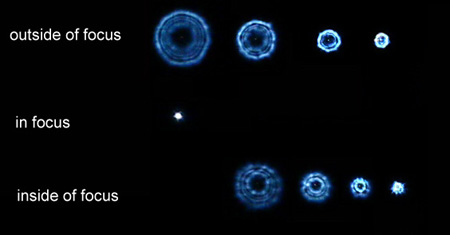
A star test
To give another perspective: These are a photos of Mars and Saturn which I've taken taken through this telescope (with a 5X powermate).
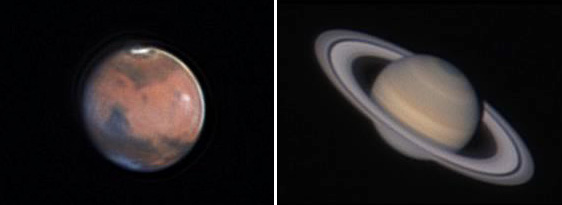
Photos of Saturn and Mars taken with the BKP250 Newtonian
Vignetting
Skywatcher tried to make "astrophotography" version so they increased the back focus to 135mm, which also enabled them to shorten the OTA. Both of these parameters are generally considered good. However the back focus is too long, considering the tube flimsiness. Also it introduces additional difficulties when balancing the mount.
Another issue: Increasing the back focus usually requires a larger secondary mirror. However this Newtonian got only got 58mm secondary which clearly isn't enough. There is a slight vignetting (darkening) even in middle of FOV.
Using ISAAC program I produced vignetting graphs for 63mm and 75mm secondary mirrors, while the original is 58mm (graphs are for this specific OTA only). As we can see - for visual use 63mm (which I've already installed) is sufficient. For wide field photography a 75mm is a better choice to ensure illumination of a larger chip.
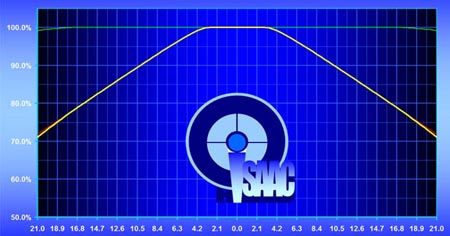
63mm diagonal mirror vignetting graph
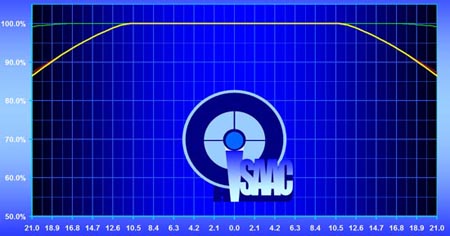
75mm diagonal mirror vignetting graph

